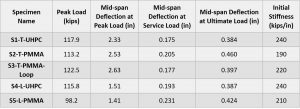January 29, 2021 1:00 pm
In this quarterly Research Seminar, Mohamed Moustafa, Ph.D., P.E., Principal Investigator; and Mohamed Abokifa, Ph.D. Student, present work under the ABC-UTC research project entitled More Choices for Connecting Prefabricated Bridge Deck Elements conducted at the University of Nevada, Reno.
Research Seminar Documents:
More Choices for Connecting Prefabricated Bridge Deck Elements - pdf of presentation
Q&A Session - pdf (to be posted soon!)
Description:
Full-depth precast bridge deck panels are widely used to expedite bridge deck erection and accelerate bridge construction. Full-depth deck joints with concave shear key type are currently common in bridge decks, with ultra-high performance concrete (UHPC) widely used for the closure pours of such joints. UHPC has superior mechanical properties but has cost and bidding challenges due to the limited number of suppliers and the special expertise needed for placement. Poly-methyl methacrylate polymer concrete (PMMA-PC) is another popular advanced construction material commonly used for overlays and can provide a potential alternative to UHPC for deck joints. PMMA-PC provides high early bond and shear strength, adequate flowability, and high durability. The objective of this study is to investigate and compare the structural performance of using PMMA-PC and UHPC for closure pours in full-depth field joints. An experimental program was conducted to test five full-scale specimens under monotonic vertical loading. Three specimens represent transverse deck panel joints, and two other specimens represent longitudinal joints in deck-bulb tee girders (DBTs). Results and discussions of the tests are presented.
Presenters:
Mohamed A. Moustafa, Ph.D., P.E.
Assistant Professor
Civil and Environmental Engineering Department
University of Nevada, Reno
Mohamed Abokifa, Ph.D. Student
(Ph.D., Summer 2021, UNR)
Civil and Environmental Engineering Department
University of Nevada, Reno
Presentation Graphics:
Figure 1. Test matrix
Figure 2. Dimensions and design details of the transverse specimens
Figure 3. Test setup of the transverse specimens: (a) schematic drawing of setup, and (b) photograph of actual setup at UNR
Figure 4. Summary of results







